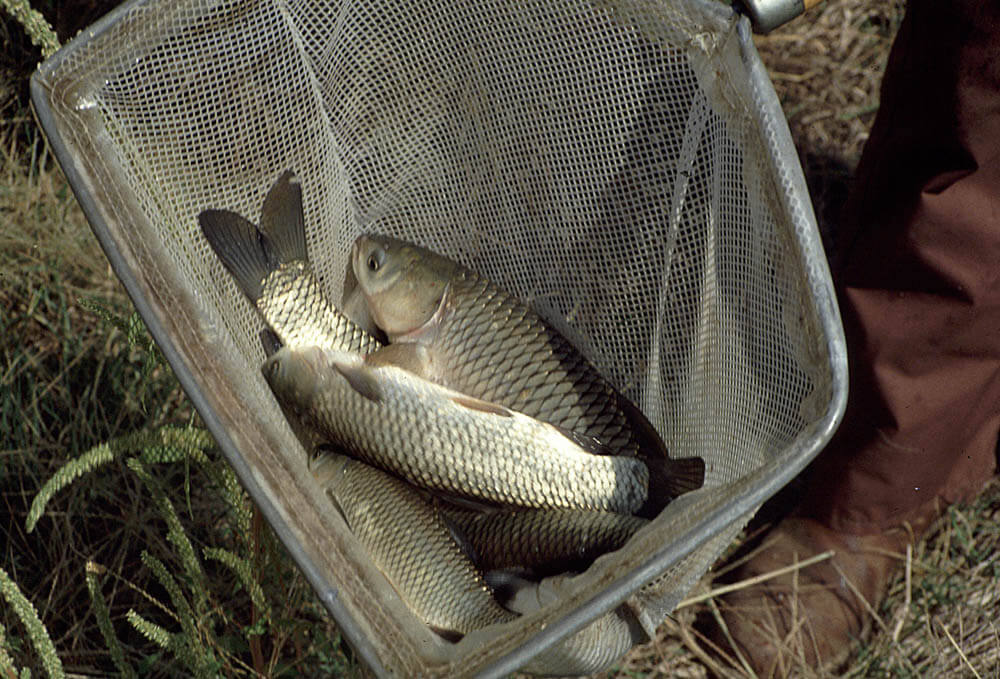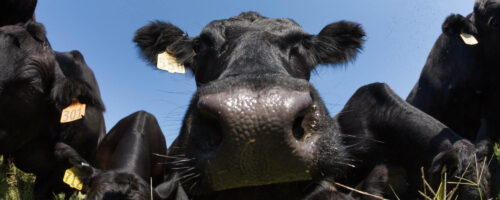This article originally appeared in the May 2017 Ag News and Views newsletter, revised 2023.
Grass carp (Ctenopharyngodon idella) is native to eastern Asia and has been introduced to North America for controlling aquatic plants in impoundments. With unlimited food, it can grow relatively large and is one of the fastest growing fish species.
Diploid vs. Triploid
Most of my experiences with grass carp involved diploid grass carp, which have two sets of chromosomes. During the past 34 years, I monitored diploid grass carp impacts on aquatic plants in dozens of Oklahoma impoundments. When restrained in an impoundment larger than 2 acres, diploid grass carp typically controlled submersed aquatic plants for 20 to 30 years. As an example, we applied rotenone to three ponds ranging in size from 2.3 to 4.1 acres 21 years after stocking grass carp, and we recovered 58 percent of the grass carp (grass carp cannot reproduce in impoundments). Grass carp controlled aquatic plants until the time we removed them; after removing them, aquatic plants reappeared. Control typically lasted less than 20 years in small ponds and ponds without proper barriers on spillways.
Since Jan. 1, 2012, only triploid grass carp may be stocked in Oklahoma because some diploid grass carp escaped into streams, where it tended to cause problems. Diploid grass carp can reproduce in rivers and reduce aquatic plants important to many fish and wildlife species. A triploid grass carp has an extra set of chromosomes, which makes it sterile. Today, most states that allow grass carp stocking into impoundments require triploid grass carp to be stocked. In my experience, triploid grass carp do not seem to live as long or control submersed aquatic plants as well as diploid grass carp.
Use Fish Barriers
Grass carp probably is the least expensive and longest-lasting option for controlling submersed aquatic plants and some emersed aquatic plants in impoundments. However, stocking grass carp comes with responsibility. People who stock grass carp into impoundments have a responsibility to keep them in impoundments. Grass carp can escape an impoundment when as little as 3 inches of water flows over a spillway. Thus, grass carp should not be stocked into an impoundment that overflows without a proper fish barrier across the spillway. Information about fish barriers is available at Box Type Parallel Bar Barrier and Panel-Type Parallel-Bar Fish Barriers. Without installation of a proper fish barrier, an impoundment manager does not know whether lack of aquatic plant control is due to inadequate stocking rate or emigration. Even an impoundment manager without an environmental conscience should be concerned about escape because investment in grass carp is wasted when they escape.

Stocking Rates
Usually, stocking rates somewhere in the range of three to 10 diploid per surface acre substantially reduce submersed aquatic plants. More triploid grass carp are usually required to obtain the same results as diploid grass carp. In my opinion, partial aquatic plant control is usually more desirable for many goals than total elimination. Unfortunately, no single stocking rate always provides a specific degree of partial control. Partial aquatic plant control with grass carp tends to require a trial and error approach. Stock a few per acre (usually three to four diploid grass carp per acre) initially, monitor an impoundment for a couple years, and stock another one or more per acre if desired results are not obtained after two years. Duration of partial control typically lasts fewer years than total control because partial control may cease when only a few grass carp die. Overall impact of grass carp stocking may not be apparent until two years after stocking. It is easier to add a few more than it is to remove them when too many are stocked. Stocking rates of 10 to 14 diploid grass carp per surface acre typically eliminate all plants that they eat. However, sometimes stocking rates as low as four per acre can eliminate all plants that they eat.
Grass carp should be at least 10 inches long when stocked into impoundments with adult largemouth bass or into impoundments visited by great blue herons, common egrets or double-crested cormorants to minimize predation by these species.
Plants Controlled
Diploid grass carp consistently controlled most, possibly all, submersed aquatic plants in Oklahoma impoundments such as filamentous algae, chara, southern naiad, pondweeds and coontail. Diploid grass carp consistently controlled a few emersed plants such as creeping water primrose, but they did not control water willow and common reed and usually did not control cattail or California bulrush. We do not know whether triploid grass carp control the same plant species as diploids, but triploids seem to control most submersed aquatic plants.
Grass Carp Not Always the Answer
Grass carp should not be stocked into all impoundments. Aquatic plants help remove pollutants, reduce clay turbidity, provide fish habitat, stabilize impoundment sediments and shorelines, and attract migratory ducks. Many impoundments do not have excessive aquatic plants, and having aquatic vegetation is desirable for several impoundment management goals. Thus, grass carp is undesirable in many situations.
GRASS CARP FACTS
FAMILY
Grass carp is one of the largest members of the minnow family, Cyprinidae, and is native to eastern Asia.
PHYSICAL DESCRIPTION
The back of grass carp is silvery to dark gray or dark olive, and the sides of the body are lighter with a slightly golden, brownish yellow or slivery sheen. The belly is silvery white. Fins are generally greenish-gray. The fish has relatively large scales. The body is somewhat torpedo-shaped versus somewhat flattened like common carp or bluegill. The mouth is terminal (at the front of the head). It lacks barbels on the lips or mouth. It is primarily a herbivore and has specialized structures called pharyngeal teeth located in the back of the throat that are used for cutting and grinding plant matter.
REPRODUCTION
Grass carp cannot reproduce in an impoundment because it requires substantial stretches of flowing water for natural fertilized egg development. Diploid carp have reproduced in several U.S. rivers, where they are considered an undesirable invasive species.
OKLAHOMA ROD AND LINE RECORD
Length: 49 in
Weight: 68 lb 15 oz
Location: Chelsea City Lake
OKLAHOMA UNRESTRICTED RECORD
Length: 53 in
Weight: 77 lb
Location: Arbuckle Lake
TEXAS ROD AND REEL PUBLIC FRESHWATER RECORD
Length: 49 in
Weight: 53 lb 8 oz
Location: Toledo Bend
TEXAS BOW FISHING RECORD
Length: 48.25 in
Weight: 85 lb 4 oz
Location: Sam Rayburn
Did you know?
Grass carp probably is the least expensive and longest-lasting option for controlling submersed aquatic plants and some emersed aquatic plants in impoundments.



Comment